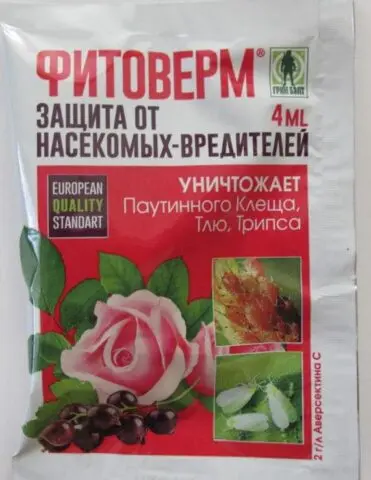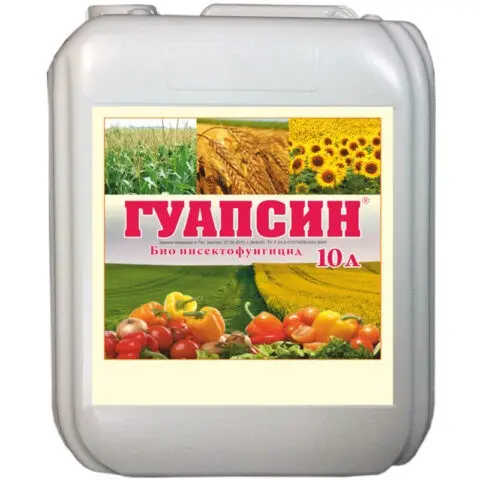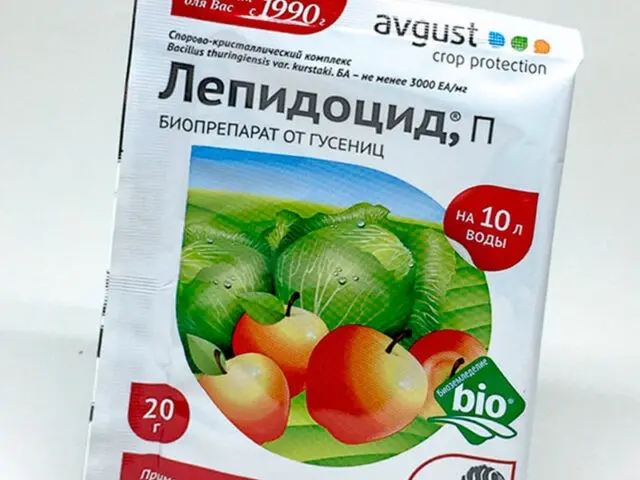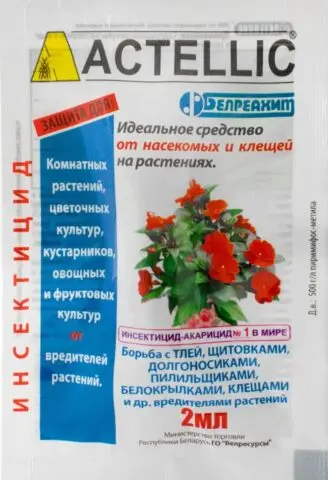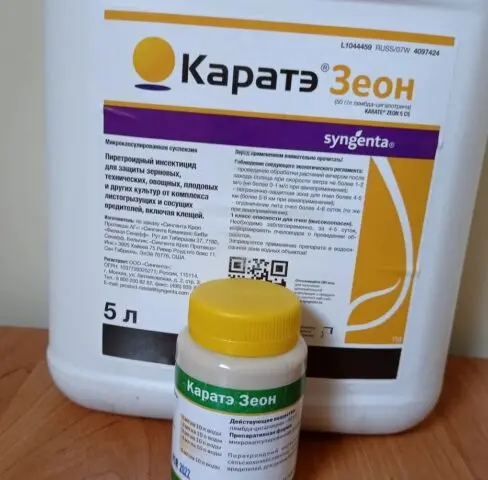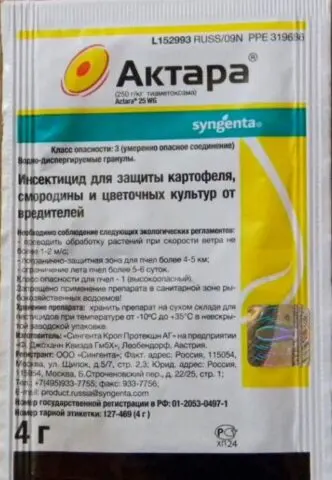Contents
Eggplants, like all garden crops, are susceptible to attack by pests. If protection measures are not taken in a timely manner, there is a risk of being left without a crop. You can treat eggplant from pests with biological, chemical and folk remedies, depending on the stage of development. Also, to reduce the likelihood of damage, agrotechnical measures should be applied. All this together helps to minimize the damage that pests cause to plants, and guarantees a good harvest at the end of the season.
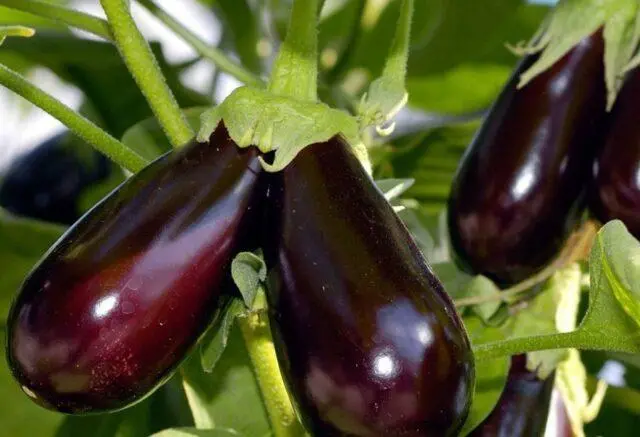
Eggplants are a favorite delicacy for many pests.
How to deal with pests on eggplant
To protect this heat-loving culture from the invasion of insects, you need not only to use the right means, but also to be able to recognize the defeat at the initial stage. To do this, you need to study the description with a photo of the main pests of eggplant seedlings. After all, insects can affect not only the aboveground, but also the root system of plants. Since the volume and quality of the harvested fruits depend on the timely processing of eggplants from pests.
Colorado beetle
This arthropod of the leaf beetle family causes serious damage to the aerial parts of eggplants. The body size of the pest is about 10 mm. The insect has a bright yellow or orange color. The pronotum of the pest has dark spots, and there are five black stripes on the elytra.
Colorado potato beetle (Leptinotarsa decemlineata) is characterized by voracity and high fecundity. Adults and larvae destroy leaves, petioles and even eggplant stems.
The insect hibernates in the soil at a depth of 20-30 cm, and by the end of spring it begins its active years and mating season. After 2-3 days, the females lay their eggs on the back of the eggplant leaves. After 5-17 days, larvae appear from them.
To combat the Colorado potato beetle, it is recommended to use insecticides with the mass appearance of offspring. Moreover, eggplants need to be sprayed several times, alternating preparations, since the pest is highly resistant to poisons. Also, deep autumn plowing is recommended to reduce the number of wintering insects.
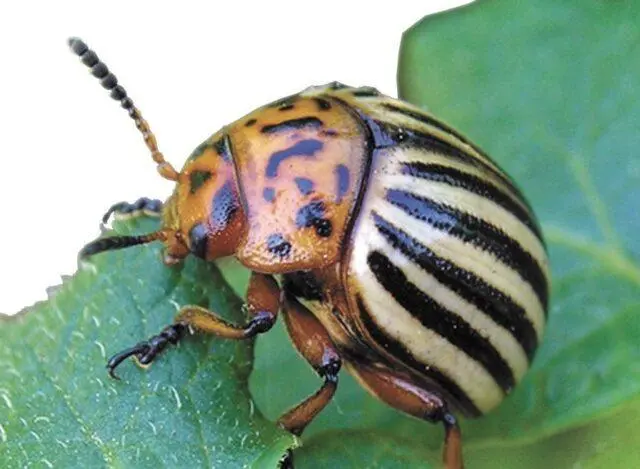
The Colorado potato beetle is a carrier of viral and bacterial diseases.
TRIPS
This pest is distributed throughout the world. It is distinguished by an elongated body, the length of which is from 0,5 to 1,5 mm. Thrips feed on the juice of eggplant leaves. This leads to deformation of the plates, slowing down development and reducing yields.
The life cycle of the pest is 30 days. During the season, 3-4 generations of thrips appear. The increased activity of the pest is observed at a temperature of +20-25 °C and low humidity.
To combat thrips, chemical and biological preparations should be used at the first signs of damage, as well as watering eggplants with insecticides, since the larvae go into the topsoil before the stage of transformation into an adult. Regular irrigation of bushes, timely weeding, and crop rotation help to reduce the number of this pest.
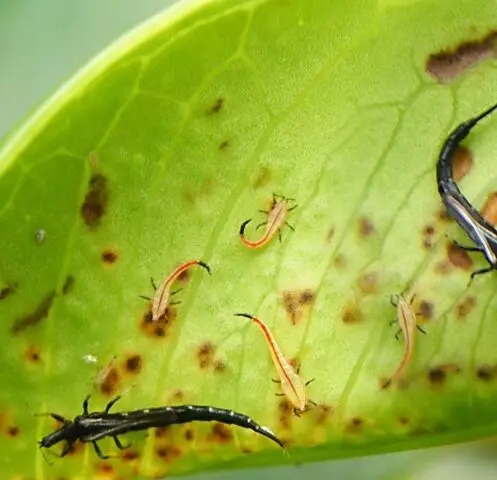
Thrips die at temperatures above +40 ° C
aphid
This pest is a small insect whose body length is from 1 to 10 mm, depending on the species. The aphid (Aphidoidea) feeds on the juice of only young leaves and shoots of eggplant. Forms entire colonies that can cause serious damage to the culture in the absence of control measures.
The danger of the pest is also that the products of its vital activity are a favorable environment for the reproduction of the sooty fungus, which prevents photosynthesis. Aphids are activated at temperatures above +15 ° C. Up to ten generations of this pest appear per season.
You need to fight aphids by spraying eggplant bushes with insecticides and biological products when the first signs of damage appear. Agrotechnical measures should also be applied.
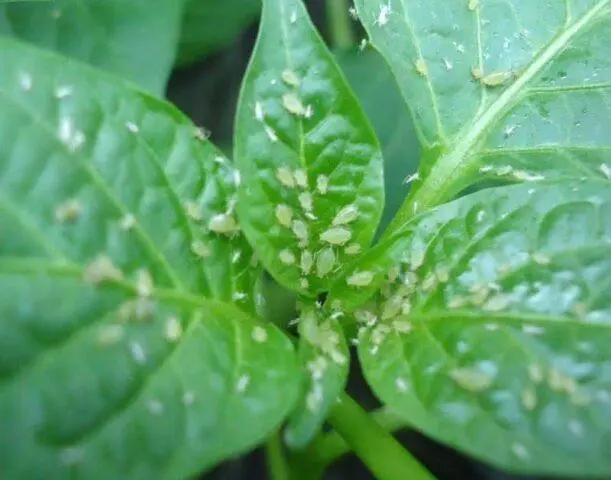
In nature, there are about five thousand species of aphids.
spider mite
This is a small pest that is difficult to see with the naked eye. The spider mite (Tetranychus urticae) feeds on the cell sap of many plants, including eggplants. You can recognize the lesion by small bright dots that are concentrated along the edges of the leaves. Subsequently, the plant takes on a dejected appearance, its growth stops, and a small cobweb appears on the tops of the shoots.
This pest often appears on eggplant seedlings on the windowsill, in the greenhouse, and also in the summer in the open field with a long absence of rain.
To fight, you need to use acaricides, spraying the aerial part of the plants twice with a frequency of once a week. It is also recommended to dust the bushes with folk remedies to prevent damage.

The spider mite is activated at elevated temperatures and low humidity.
Scoops
This pest causes damage to eggplants at an early stage of development, which leads to their death. Scoops (Noctuidae) are small butterflies 2 cm long and with a wingspan of 3,5-5 cm. Females are larger than males. The front wings of the scoop are brown, with dark spots.
Damage to eggplants is caused by caterpillar larvae of a brown scoop. They eat the juicy eggplant shoots from the inside, and also feed on the leaves and fruits. The larvae are nocturnal, and during the daytime they hide in the upper soil layer. During the season, 1-2 generations of scoops appear.
To combat these pests, it is necessary to spray and water eggplants with insecticides 2-3 times with a break of seven days, as well as regularly loosen the soil at the base of the bushes and remove weeds in a timely manner, as well as observe crop rotation.
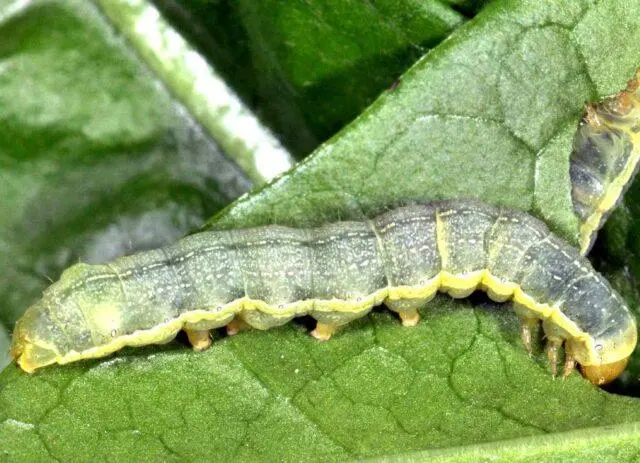
Eggplants suffer mainly from winter and exclamation cutworms
whitefly
This heat-loving insect most often infects seedlings at home and greenhouse conditions. It is provoked by high humidity in combination with high temperature. The whitefly (Aleyrodidae) is a flying insect that resembles a midge in appearance. Its size reaches 5 mm. The peculiarity of this pest is that its body and wings are white, for which it got its name.
You can identify the lesion if you touch the eggplant seedlings. In this case, a swarm of whiteflies flies up. Adult pests and larvae feed on plant sap, which weakens them and makes them susceptible to diseases.
It is necessary to carry out the fight against this pest in a complex manner. To do this, it is necessary to water and spray the eggplants with insecticides at intervals of once every seven days until the signs of damage completely disappear. You should also control watering and regularly loosen the soil at the base of the plants.
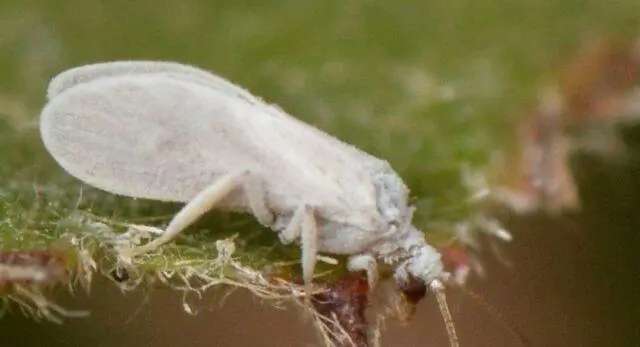
The appearance of the whitefly is easier to prevent than to fight it later.
Medvedka
This underground pest that feeds on soil insects. In the course of his life, he makes moves that disrupt the growth of the eggplant root system. Medvedka (Gryllotalpidae) is a large insect whose body size is 6-8 cm. The pest has a hard shell on the chest, two pairs of limbs and long scaly wings. The color of the body is dark brown.
The bear lives in the ground at a depth of 10-15 cm. It comes out only at night. It is very difficult to catch this pest, because it flies well, swims and quickly digs moves. The life cycle lasts 1,5-2 years.
To combat this pest, it is recommended to use toxic baits, which should be laid in the holes when planting eggplants. And also crushed eggshells help to get rid of the invasion.
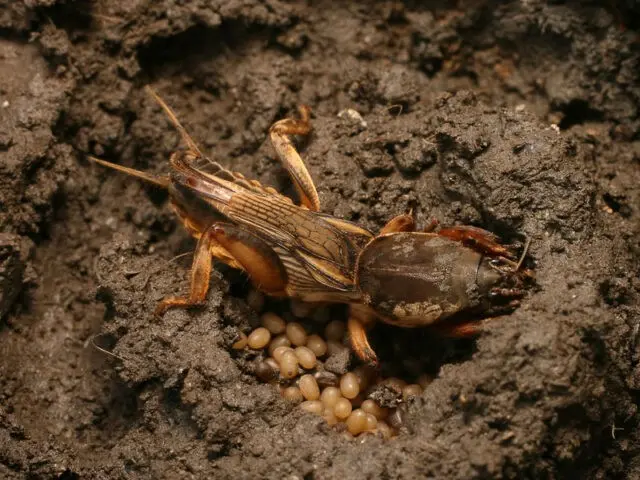
Medvedka prefers areas rich in organic matter
Slugs
These gastropods feed on young leaves and shoots of eggplant. The size of slugs varies from 5 to 7 cm. Every day they absorb food much more than their own body weight. Slugs (Biobest) are nocturnal and prefer to settle in damp places.
To control pests, sprinkle the soil at the base of the eggplants with metaldehyde-based preparations, as well as use wood ash and crushed eggshells.
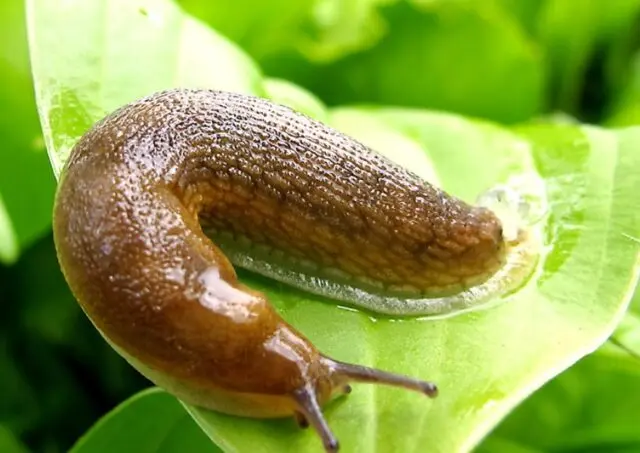
Slugs are characterized by increased fertility and low susceptibility to insecticides.
Cruciflo flea
This pest is a flying beetle, ranging in size from 0,15 to 0,3 cm. There are many types of cruciferous flea (Phyllotreta crusiferae), which differ in the color of the elytra. Damage to eggplants is caused by pest larvae that live in the upper soil layer and eat thin roots.
To combat adults, it is recommended to spray the plants with special preparations and folk remedies, and against the larvae, you need to water the eggplant from pests with an insecticide solution.
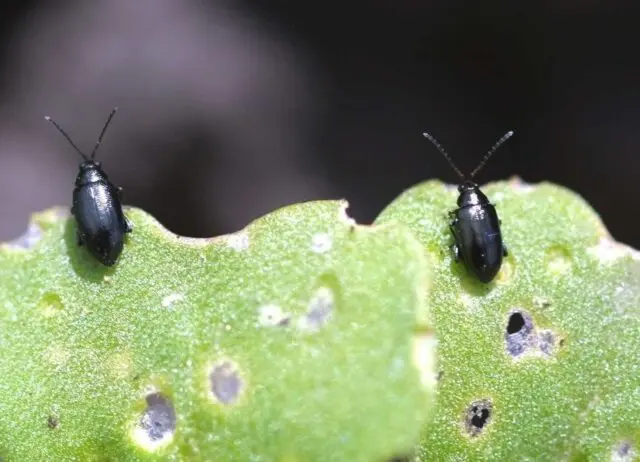
The cruciferous flea is striped, black or metallic.
How to protect eggplant from pests
To protect eggplant from the invasion of pests, it is necessary to apply different methods of dealing with them. Only in this case it is possible to reduce the damage and keep the yield at a high level.
Biological agents
The basis of these drugs are microorganisms or substances produced by them, which have a detrimental effect on pests. They help protect eggplant from ticks, caterpillars, adults and larvae. The active substances included in their composition, penetrating into the body of an insect after eating the treated plant, accumulate and cause intoxication.
These funds include:
- Fitoverm;

Fitoverm – insectoacaricide that protects against 20 types of insects
- Guapsin;

Guapsin has insecticidal and fungicidal actions.
- Lepidocide.

Lepidocid – not effective against spider mites
Chemicals
These tools help to quickly solve the problem and drastically reduce the number of pests. However, with repeated treatments, they need to be alternated, as they can be addictive in insects.
The most effective chemicals:
- Aktellik;

Actellik – contact organophosphorus insectoacaricide
- Confidor Extra;

Confidor Extra has a long protective effect
- Karate Zeon;

Karate Zeon – UV and rain resistant
- Aktara.

Aktara – suitable for watering and spraying eggplants
Folk methods
Folk remedies can also be used against pests on eggplant. They are suitable for the prevention of damage, as well as with a small number of insects.
Effective recipes:
- Potato tops. Cut 250 g of nightshade shoots, pour 1 liter of water and boil for 15 minutes. After the product has cooled, it must be filtered. Spray the decoction of eggplant from pests, but after diluting it with water in a ratio of 1:5.
- Hot peppers. Grind 100 g of pods. Pour 1 liter of water and boil for an hour. When the product has cooled, pour it into a dark bottle, insist for a day. Before use, the resulting concentrate must be diluted with water 1:10, and then the eggplant seedlings should be treated for pests.
- Garlic. It is necessary to grind four cloves and pour the resulting mass of 1 liter of warm water. After a day, strain the infusion. Treat eggplant with pest control if insects eat leaves.
Agrotechnical events
Simple agricultural practices also help reduce the likelihood of eggplant damage by pests. But their effectiveness directly depends on the regularity of the implementation.
Main events:
- deep plowing of the site for the winter;
- mulching plantings with wood ash, dried nettles, spruce needles;
- observance of crop rotation;
- planting along the perimeter of the beds of marigolds, calendula, garlic;
- destruction of plant residues after harvest.
Conclusion
It is necessary to process eggplants from pests in a timely manner when the first warning signs appear. Also, experienced gardeners recommend soaking the roots of seedlings in an insecticide solution before planting in the garden to protect them at the initial stage of growth and allow them to get stronger. Only using different methods of protection, you can protect this crop from pests.










